|
Julia Ward Howe
Crusader for World Peace
|
ABOUT ACTRESS JANE SMITH BERNHARDT
From
Auschwitz to Hiroshima, from Russia to our inner
cities, teacher, author, portraitist, and actor,
Bernhardt’s art has taken her all over the world.
A
third generation portrait artist and seasoned actor
of stage and television, graduating from the
American Academy of Dramatic Arts in Manhattan, she
poignantly combines her portrait skills and acting
in projects such as the Hibakusha Peace Project
recently performed on our stage at the Actor’s
Studio. The Project is a multimedia tribute to the
survivors of Hiroshima.
Jane
Bernhardt's Living Histories have been performed for
kindergartners through seniors, in theatres, churches,
synagogues, libraries, schools, and retirement homes.
Contact Jane
for
details at:
janesb@comcast.net
|
|
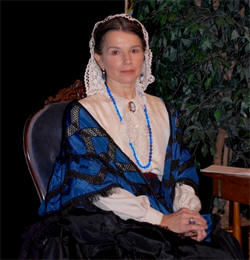
Photo by
Arlene Barnard
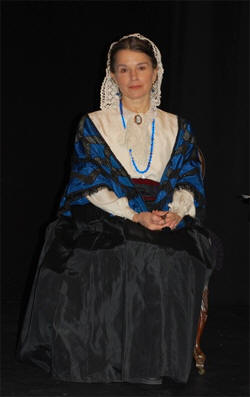
Photo by
Arlene Barnard
|
Julia Ward Howe
(1819-1910) – A brief biography
Extracted from
“Julia Ward Howe: Beyond the Battle Hymn of the
Republic”,
an article written by Jone Johnson Lewis
Julia Ward and Samuel Gridley Howe
Born Julia Ward in New York City, the fourth of seven
children, at age 24 she married the reformer Samuel
Gridley Howe, director of the Perkins Institute for the
Blind in Boston, Massachusetts. He was part of the
Transcendentalists movement and an opponent of slavery.
Samuel had married Julia, admiring her ideas, her quick
mind, her wit, her active commitment to causes he also
shared. But Samuel believed that married women should
not have a life outside the home, that they should not
speak publicly or be active themselves in the causes of
the day.
The marriage was increasingly stifling to her. She
studied philosophy on her own, learned several languages
— at that time a bit of a scandal for a woman — and
devoted herself to her own self-education and of their
children. She also worked with her husband on a brief
venture at publishing an abolitionist paper. She began,
despite his opposition, to get more involved in writing
and in public life.
Writing the Battle Hymn of the Republic
With the passage of the Fugitive Slave Act, all US
citizens, even in states that banned slavery, were
legally bound to return fugitive slaves to their owners
in the South, pushing many who opposed slavery into more
radical abolitionism. Clergyman, James Freeman Clarke,
who knew of Julia's published poems, urged her to write
a new song for the war effort to replace "John Brown's
Body." The result was a poem, published first in
February 1862 in the Atlantic Monthly, and called
“Battle Hymn of the Republic” The poem— to a tune
originally written by a Southerner for religious
revivals—became the best known Civil War song of the
North.
"As he died to make men holy, let us die to make men
free." Turning from the idea that the war was revenge
for the death of a martyr, Howe hoped that the song
would keep the war focused on the principle of the
ending of slavery.
Today, that's what Howe is most
remembered for: as the author of the song, still loved
by many Americans, still hated by many Southerners. Her
early poems are forgotten — her other social commitments
forgotten. She became a much-loved American institution
after that song was published — but even in her own
lifetime, all her other pursuits paled besides her
accomplishment of one piece of poetry for which she was
paid $5 by the editor of Atlantic Monthly.
Mother's Day and Peace
In 1870, Julia Ward Howe took on a new issue and a new
cause. Distressed by her experience of the realities of
war, determined that peace was one of the two most
important causes of the world (the other being equality
in its many forms) and seeing war arise again in the
world in the Franco-Prussian War, she called in 1870 for
women to rise up and oppose war in all its forms. She
wanted women to come together across national lines, to
recognize what we hold in common above what divides us,
and commit to finding peaceful resolutions to conflicts.
Influenced by Anna Jarvis, a young Appalachian homemaker
who had attempted starting in 1858 to improve sanitation
through what she called Mothers' Work Days, she issued a
Declaration, hoping to gather together women in a
congress of action.
Anna Jarvis' daughter started her own crusade to found a
memorial day for women. The custom caught on — spreading
eventually to 45 states. The holiday was declared
officially by states, and in 1914 the President, Woodrow
Wilson, declared the first national Mother’s Day.
Woman Suffrage
By 1868, with her colleague Lucy Stone, Julia Ward Howe
was helping to found the New England Suffrage
Association. She began to lecture and write frequently
on the subject of woman suffrage.
In 1870 she helped Stone and her husband, Henry
Blackwell, found the Woman's Journal, remaining
with the journal as an editor and writers for twenty
years.
 After
her husband’s death, she traveled for two years in
Europe and the Middle East. When she returned to Boston,
she renewed her work for women's rights. In 1889 helped
bring about the merger of the AWSA with the rival
suffrage organization, led by Elizabeth Cady Stanton and
Susan B. Anthony, forming the National American Woman
Suffrage Association (NAWSA). After
her husband’s death, she traveled for two years in
Europe and the Middle East. When she returned to Boston,
she renewed her work for women's rights. In 1889 helped
bring about the merger of the AWSA with the rival
suffrage organization, led by Elizabeth Cady Stanton and
Susan B. Anthony, forming the National American Woman
Suffrage Association (NAWSA).
In her last years, she was often compared to Queen
Victoria, whom she somewhat resembled and who was her
senior by exactly three days. When Julia Ward Howe died
in 1910, four thousand people attended her memorial
service.
|
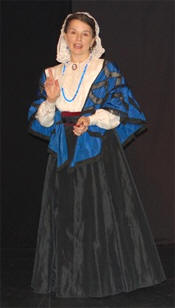
Photo by Arlene Barnard
Julia Ward
Howe,
Crusader for World
Peace.
This
forty minute performance traces Howe's journey from
dutiful nineteenth century wife and champion of the
Union cause to suffragette and crusader for world peace.
Contact Jane for details and to schedule a
performance.
email
Jane
Phone:
603.793.9789
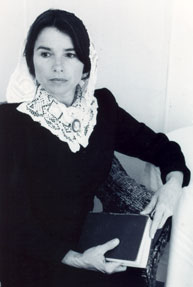
Jane as
Julia
Ward Howe
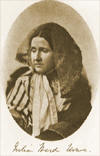
CLICK
To Learn more about
Julia Ward Howe
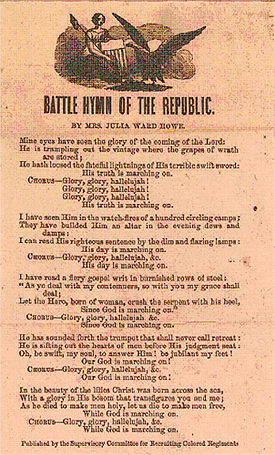
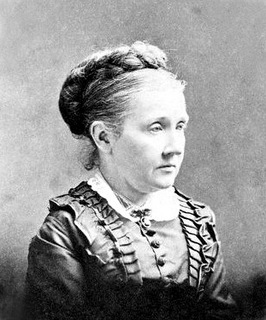
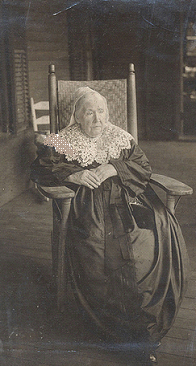

CLICK
To Learn more about
Julia Ward Howe
|